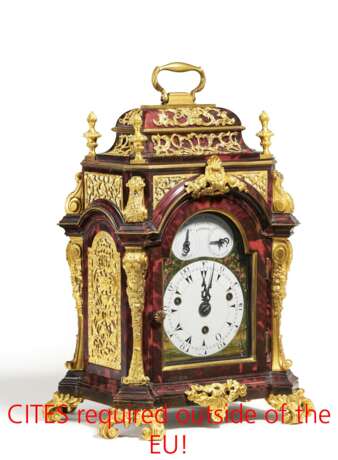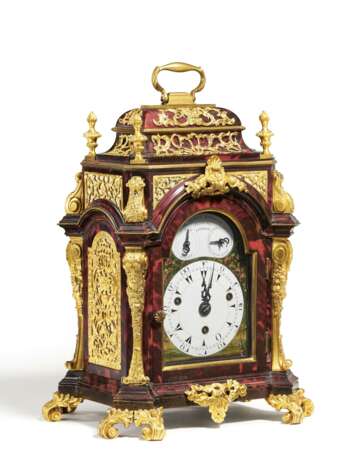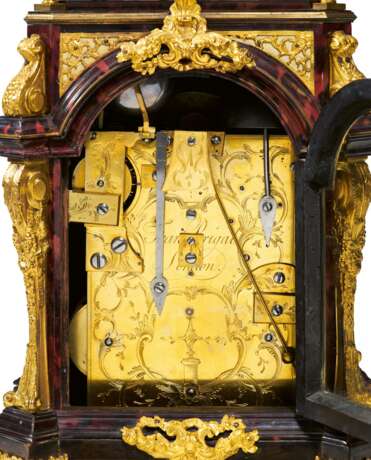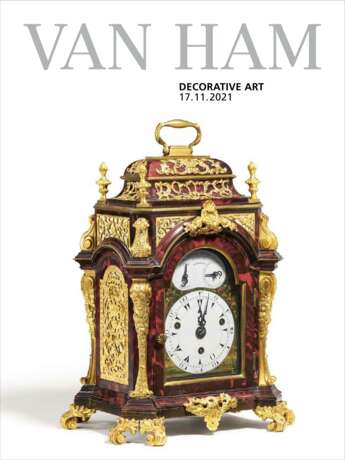ID 647735
Lot 11 | Exquisite George III Bracket Clock made of wood, tortoiseshell and firegilt bronze
Estimate value
€ 45 000 – 55 000
Markwick Markham & Francis Perigal. London
Date: Around 1770.
Technique: Wooden corpus with tortoise shell veneer, fire gilt bronze and other materials.
Description: The empty spandrels and interstices on the front plate finely painted with floral bouquets and landscape view. The case veneered with tortoise shell and richly decorated with fine, fire-gilt bronze appliqués. Enamel dial with indexes. Richly engraved full plate movement, the short pendulum with blade suspension. 8-day movement with verge escapement, fusee and gut string. The latter replaced by steel cable. Carillon on 6 bells with 4 selectable Turkish tunes, which sound after the hour strike (termed: 'Beni Saiket', 'Samahe', 'Vschae Devir', 'Sabac Hafif'). Duration of each melody approx. 30 seconds.
Striking and count wheel mechanism. Regulator for striking mechanism and carillon in front above the clock hands.
Measurement: 37,5x26,5x20cm.
Mark: Plate on the back signed Franc. Perigal London.
(S).
Provenance:
Private collection Hamburg.
2000 purchased at Pelham Galleries LTD, London.
Literature:
Loomes (2006), p.606 & 507.
Loomes, Brian: Markwick Markham, 2013. (https://www.brianloomes.com/collecting/markwick/index.html)
n eighteenth-century Europe, there was a growing interest in Eastern cultures. Both the Far East and the Middle East were a great source of inspiration for artisans, leading to the art movements known as Chinoiserie and Turquerie. That the East was also interested in objects from the West is not as well known. Many clocks, especially from England, found their way into imperial circles in China, where clocks with elaborate movements or artfully constructed automata were very popular. Elaborately decorated cases with exquisite ornamentation and fancy patterns were much sought after.
In the course of the 18th century, more and more table clocks were produced for the so-called Turkish market, which at that time encompassed the old Ottoman Empire and thus most of the Middle East. In order to meet the wishes of the Ottoman clients, the manufacturers of the clocks had to take into account the laws of the Islamic religion. For example, the depiction of human figures was forbidden, but the depiction of landscapes, buildings or ships was permitted. In addition to the quality and precision of the table clock as a device showing the time, however, emphasis was also placed on musical features through a complicated musical mechanism that played melodies for the intended market.
The cases, as here, were usually decorated with tortoiseshell or lacquer work. In some cases, however, they were also decorated with crystal domes and pinnacles. Gilt bronze fittings were not considered too extravagant by buyers, but a logical element of this type of clock. Dials with Turkish- instead of the Roman numerals common in the West werer requested as well.
To a certain extent, the Ottoman market was dominated by a few London manufacturers. Among these was Markwick-Markham, founded by James Markwick Junior and his son-in-law Robert Markham, who soon expanded their cooperation into a very flourishing business. The present bracket clock was created in collaboration with Francis Perigal, who was known for producing fine and technically sophisticated clocks. The outstanding quality of the fire-gilt appliqués on this clock suggests that it was made in the 1770s.
| Manufactur: | Markwick Markham & Francis Perigal |
|---|---|
| Auction house category: | Clocks and Watches |
| Manufactur: | Markwick Markham & Francis Perigal |
|---|---|
| Auction house category: | Clocks and Watches |
| Address of auction |
VAN HAM Kunstauktionen GmbH Hitzelerstr. 2 50968 Köln Germany | ||||||||||||||
|---|---|---|---|---|---|---|---|---|---|---|---|---|---|---|---|
| Preview |
| ||||||||||||||
| Phone | +49 221 92586215 | ||||||||||||||
| Fax | +49 221 92 58 62 4 | ||||||||||||||
| Buyer Premium | 32% | ||||||||||||||
| Conditions of purchase | Conditions of purchase | ||||||||||||||
| Business hours | Business hours
|









